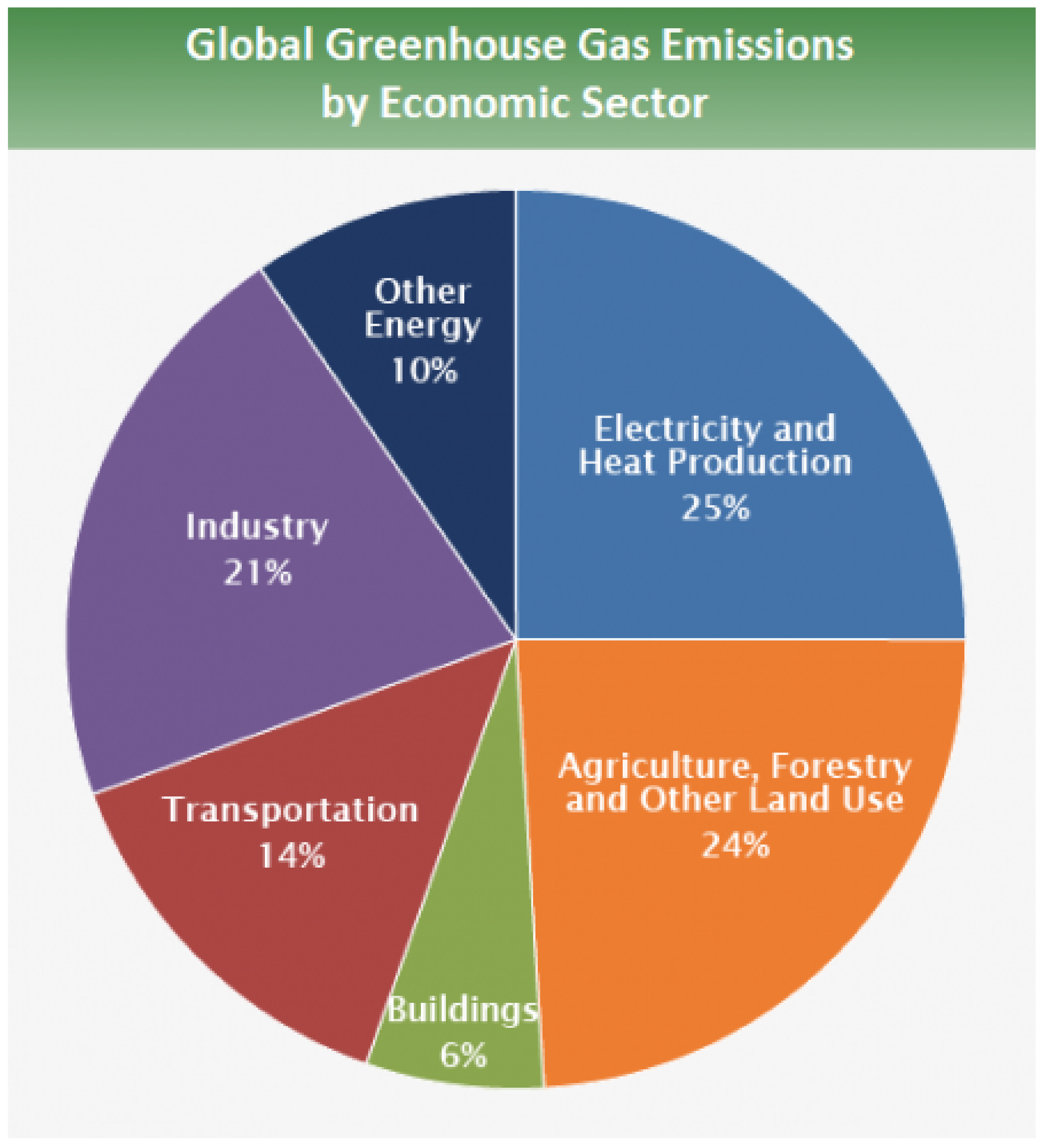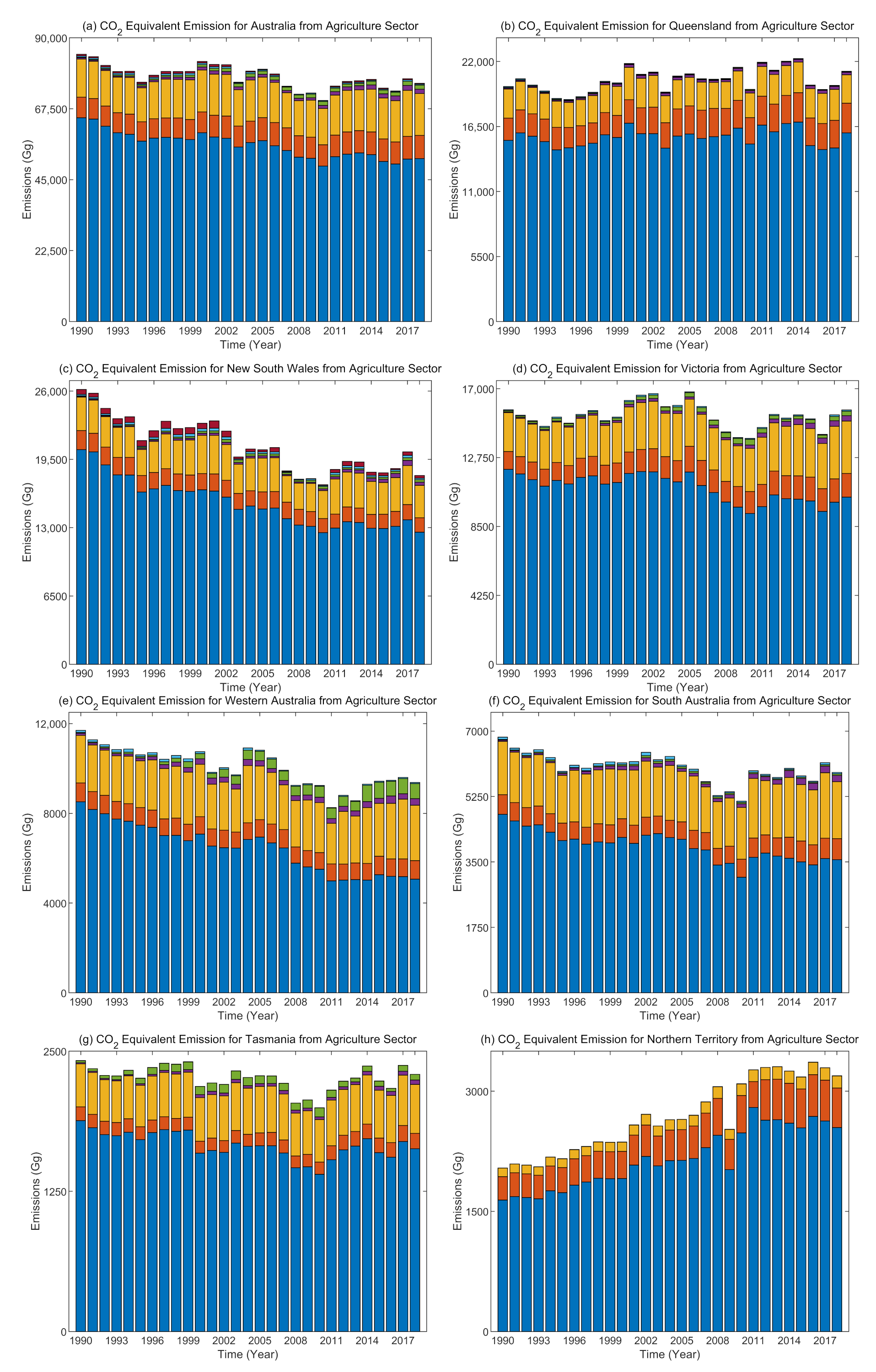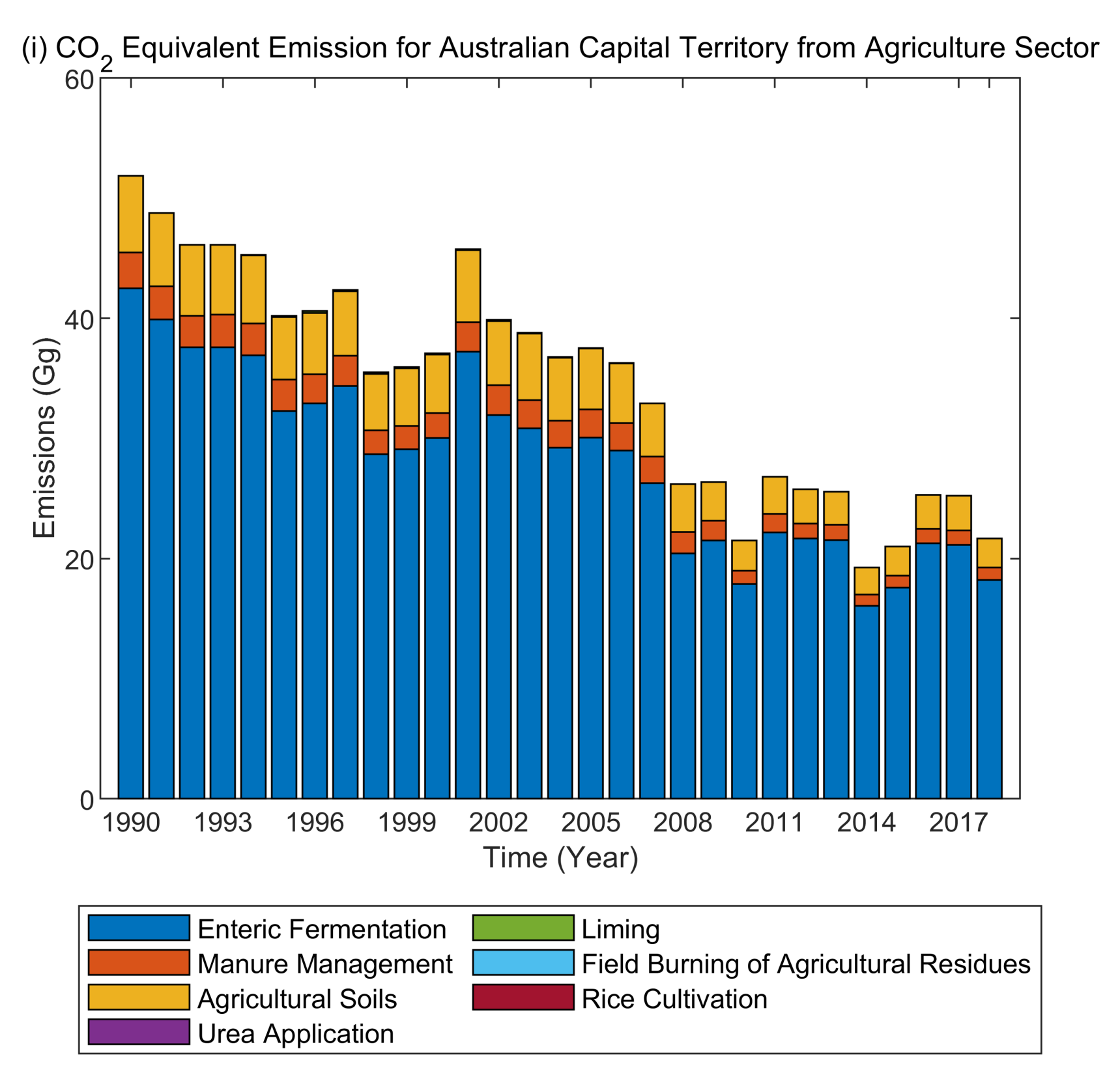Greenhouse Gas Emissions Trends and Mitigation Measures in Australian Agriculture Sector—A Review
Abstract
:1. Introduction
2. Motivation
- To map the GHG emission trend from the agricultural section in Australia based on open source data sets.
- To explore the GHG mitigation strategies within Australian agricultural sector.
- To review of currently used techniques used within the agriculture sector.
- To suggest practices to help curb the GHG emissions from Australian agriculture.
3. Australia’s Greenhouse Gas Emissions
4. Emissions from Agriculture
5. Common Techniques Used in Agriculture
6. Low GHG Emisison Practices in Agriculture
6.1. Smart Farming/Smart Agriculture
- Field Monitoring: Smart farming helps to reduce spoilage and crop waste with the provision of better monitoring, accurate data collection, and management of the agriculture fields [27]. For instance, smart farming promotes the efficient application of fertilizers, electricity and water.
- Green Houses: Smart farming helps to maximize the production and quality of fruits and vegetables by controlling micro-climate conditions of a green house [28].
- Compost management: Smart technologies prevent fungus and other microbial contaminants in hay, alfalfa, straw, etc. by controlling temperature and humidity [29].
- Livestock Farming: Smart livestock farming helps to monitor animal grazing in open pastures or location in big stables [30]. smart farming also helps in detecting and maintaining air quality, ventilation in farms and detecting and reducing GHG emission from farms.
- Offspring Care: Smart farming helps in monitoring and controlling offspring in animal farms to ensure their survival, growth and health [29].
6.1.1. Climate Smart Agriculture
- Carbon-smart practices, which are focused on reducing GHG emission. Examples include [36]:
- Integrated Pest Management (IPM), which is designed to minimize the use of chemicals.
- Agro Forestry (AF) and Fodder management (FM). They emphasise on sustainable land management and carbon reduction.
- Concentrate Feeding (CF) for Livestock, which aims to reduce nutrient losses, hence reduces the food requirement for livestock.
- Energy-smart practices emphasize improving energy efficiency. Examples include:
- Zero Tillage/Minimum Tillage (ZT/MT) practices improve water infiltration and retention of organic matters by reducing energy consumption during land preparation [37].
- Weather-smart practices: these CSA practices utilize technology to make the farmers aware about weather conditions. Besides, they offer income security related services.
- Weather based Crop Agro(CA) advisory, where technology is used to do weather forecasting, gather relevant information on climate condition and advises the farmers accordingly [38].
- Climate Smart Housing (CSH) for livestock uses technologies to help farmers take timely and specific decisions to protect animals from extreme heat or cold stresses [32].
- Crop Insurance (CI) offers crop-specific insurance to farmers in order to compensate the losses due harms caused by weather variation or natural disasters.
- Nutrient-smart practices, which are focused on improving efficient use of nutrients, include:
- Site Specific Integrated Nutrient Management (SINM), which optimizes the supply of soil nutrients according to space, season and type of crops [39].
- Leaf Color Charts (LCC), which are used to detect nitrogen deficiency in crops, such as wheat and maize, by quantifying the required amount of nitrogen based on the greenness of crops. They are also used for split dose applications in rice fields [40].
- Green Manuring (GM) and Intercropping with Legumes (ICL). Both of these practices are used to improve quality of soil and nitrogen supply. The first one uses cultivation of legumes in cropping systems, while the former one uses the same with other main crops in alternative rows of the field [41].
- Knowledge-smart practices, which improves productivity and helps in reducing environmental footprints by using local knowledge and technology, include:
- Improved Crop Varieties (ICV) provide knowledge about varieties of crops which are more tolerant to weather variation such as floods, drought, cold/heat stresses etc. [33].
- Contingent Crop Planning (CC) provides risk management plan to be prepared for different weather conditions such as flood, drought and cold/heat stresses [42].
- Seed and Fodder Banks (SFB) are another part of the risk management plan, which provides information on the conservation mechanism of seeds and fodders [42].
6.1.2. Reducing GHG Emission with the Aid of Smart Livestock Farming
6.2. Best Management Practice Approach
6.2.1. Reduction of Methane(CH4) Emission
- Viruses to attack the microbes which produce CH.
- Specialized proteins to target CH-producing microbes.
- Other microbes to break down the CH produced in the rumen into other substances.
6.2.2. Reduction of Nitrous Oxide (N2O) Emission
7. Conclusions
Author Contributions
Funding
Institutional Review Board Statement
Informed Consent Statement
Acknowledgments
Conflicts of Interest
References
- Climate Council of Australia. Australia’s Rising Greenhouse Gas Emissions; Climate Council: Potts Point, Australia, 2018. [Google Scholar]
- Food and Agriculture Organization. World Agriculture: Towards 2015/2030: An FAO Perspective; FAO: London, UK, 2003. [Google Scholar]
- Tsujimoto, S.; Takagi, T.; Osada, T.; Ogino, A. Greenhouse gas reduction and improved sustainability of animal husbandry using amino acids in swine, poultry feeds. Anim. Sci. J. 2013, 84, 409–415. [Google Scholar] [CrossRef]
- Bellarby, J.; Foereid, B.; Hastings, A. Cool Farming: Climate Impacts of Agriculture and Mitigation Potential; Greenpeace International: Amsterdam, The Netherlands, 2008. [Google Scholar]
- Word Bank. Climate-Smart Agriculture: Increased Productivity and Food Security, Enhanced Resilience and Reduced Carbon Emissions for Sustainable Development-Opportunities and Challenges for a Converging Agenda: Country Examples; World Bank: Washington, DC, USA, 2011. [Google Scholar]
- Islam, N.; Ray, B.; Pasandideh, F. IoT Based Smart Farming: Are the LPWAN Technologies Suitable for Remote Communication? In Proceedings of the 2020 IEEE International Conference on Smart Internet of Things (SmartIoT), Beijing, China, 14–16 August 2020; pp. 270–276. [Google Scholar]
- Curry, J.; Harris, N. Powering the Environmental Internet of Things. Sensors 2019, 19, 1940. [Google Scholar] [CrossRef] [PubMed] [Green Version]
- Jackson, T.; Hatfield-Dodds, S.; Zammit, K. Snapshot of Australian Agriculture; Australian Government, Department of Agriculture and Water Resources, ABARES: Canberra, Australia, 2018.
- Chandra, A.; McNamara, K.E.; Dargusch, P. Climate-smart agriculture: Perspectives and framings. Clim. Policy 2018, 18, 526–541. [Google Scholar] [CrossRef]
- Intergovernmental Panel on Climate Change (IPCC). Mitigation of climate change. In Contribution of Working Group III to the Fifth Assessment Report of the Intergovernmental Panel on Climate Change; IPCC: Geneva, Switzerland, 2014; 1454p. [Google Scholar]
- Team, G. GISS Surface Temperature Analysis (GISTEMP), Version 4; NASA Goddard Institute for Space Studies: New York, NY, USA, 2020. Available online: https://data.giss.nasa.gov/gistemp/ (accessed on 9 July 2020).
- Lenssen, N.J.; Schmidt, G.A.; Hansen, J.E.; Menne, M.J.; Persin, A.; Ruedy, R.; Zyss, D. Improvements in the GISTEMP uncertainty model. J. Geophys. Res. Atmos. 2019, 124, 6307–6326. [Google Scholar] [CrossRef]
- Minato, K.; Kouda, Y.; Yamakawa, M.; Hara, S.; Tamura, T.; Osada, T. Determination of GHG and ammonia emissions from stored dairy cattle slurry by using a floating dynamic chamber. Anim. Sci. J. 2013, 84, 165–177. [Google Scholar] [CrossRef] [PubMed]
- Shibata, M.; Terada, F. Factors affecting methane production and mitigation in ruminants. Anim. Sci. J. 2010, 81, 2–10. [Google Scholar] [CrossRef] [PubMed]
- Jantke, K.; Hartmann, M.J.; Rasche, L.; Blanz, B.; Schneider, U.A. Agricultural Greenhouse Gas Emissions: Knowledge and Positions of German Farmers. Land 2020, 9, 130. [Google Scholar] [CrossRef]
- Tubiello, F.N.; Salvatore, M.; Rossi, S.; Ferrara, A.; Fitton, N.; Smith, P. The FAOSTAT database of greenhouse gas emissions from agriculture. Environ. Res. Lett. 2013, 8, 1. [Google Scholar] [CrossRef]
- Meier, E.A.; Thorburn, P.J.; Kragt, M.E.; Dumbrell, N.P.; Biggs, J.S.; Hoyle, F.C.; van Rees, H. Greenhouse gas abatement on southern Australian grains farms: Biophysical potential and financial impacts. Agric. Syst. 2017, 155, 147–157. [Google Scholar] [CrossRef]
- Suzuki, T.; Sommart, K.; Angthong, W.; Nguyen, T.V.; Chaokaur, A.; Nitipot, P.; Phromloungsri, A.; Cai, Y.; Sakai, T.; Nishida, T.; et al. Prediction of enteric methane emission from beef cattle in Southeast Asia. Anim. Sci. J. 2018, 89, 1287–1295. [Google Scholar] [CrossRef]
- Navarro, J.; Bryan, B.; Marinoni, O.; Eady, S.; Halog, A. Production of a map of greenhouse gas emissions and energy use from Australian agriculture. In Proceedings of the 20th International Congress on Modelling and Simulation, Adelaide, Australia, 1–6 December 2013; pp. 1–6. [Google Scholar]
- Authority, C.C.; Emissions, R.A.G.G. Targets and Progress Review Draft Report; Commonwealth of Australia: Canberra, Australia, 2013. [Google Scholar]
- Kulak, M.; Graves, A.; Chatterton, J. Reducing greenhouse gas emissions with urban agriculture: A Life Cycle Assessment perspective. Landsc. Urban Plan. 2013, 111, 68–78. [Google Scholar] [CrossRef]
- Casper, J.K. Greenhouse Gases: Worldwide Impacts; Infobase Publishing: New York, NY, USA, 2010. [Google Scholar]
- Toensmeier, E. The Carbon Farming Solution: A Global Toolkit of Perennial Crops and Regenerative Agriculture Practices for Climate Change Mitigation and food Security; Chelsea Green Publishing: White River Junction, VT, USA, 2016. [Google Scholar]
- Lal, R. Soil carbon sequestration to mitigate climate change. Geoderma 2004, 123, 1–22. [Google Scholar] [CrossRef]
- Islam, N.; Rashid, M.M.; Wibowo, S.; Wasimi, S.; Morshed, A.; Xu, C. Machine learning based approach for Weed Detection in Chilli field using RGB images. In Proceedings of the International Conference on Natural Computation, Fuzzy Systems and Knowledge Discovery, Xi’an, China, 19–21 December 2020; Springer: Berlin/Heidelberg, Germany, 2020; pp. 13–20. [Google Scholar]
- Alam, M.; Alam, M.S.; Roman, M.; Tufail, M.; Khan, M.U.; Khan, M.T. Real-Time Machine-Learning Based Crop/Weed Detection and Classification for Variable-Rate Spraying in Precision Agriculture. In Proceedings of the 2020 7th International Conference on Electrical and Electronics Engineering (ICEEE), Antalya, Turkey, 14–16 April 2020; pp. 273–280. [Google Scholar]
- Prathibha, S.; Hongal, A.; Jyothi, M. IoT based monitoring system in smart agriculture. In Proceedings of the 2017 International Conference on Recent Advances in Electronics and Communication Technology (ICRAECT), Bangalore, India, 16–17 March 2017; pp. 81–84. [Google Scholar]
- Patil, A.S.; Tama, B.A.; Park, Y.; Rhee, K.H. A framework for blockchain based secure smart green house farming. In Advances in Computer Science and Ubiquitous Computing; Springer: Singapore, 2017; pp. 1162–1167. [Google Scholar]
- Villa-Henriksen, A.; Edwards, G.T.; Pesonen, L.A.; Green, O.; Sørensen, C.A.G. Internet of Things in arable farming: Implementation, applications, challenges and potential. Biosyst. Eng. 2020, 191, 60–84. [Google Scholar] [CrossRef]
- Saravanan, K.; Saraniya, S. Cloud IOT based novel livestock monitoring and identification system using UID. Sens. Rev. 2018, 38, 21–33. [Google Scholar]
- De Pinto, A.; Cenacchi, N.; Kwon, H.Y.; Koo, J.; Dunston, S. Climate smart agriculture and global food-crop production. PLoS ONE 2020, 15, e0231764. [Google Scholar] [CrossRef] [PubMed]
- Khatri-Chhetri, A.; Aggarwal, P.K.; Joshi, P.K.; Vyas, S. Farmers’ prioritization of climate-smart agriculture (CSA) technologies. Agric. Syst. 2017, 151, 184–191. [Google Scholar] [CrossRef]
- McNunn, G.; Karlen, D.L.; Salas, W.; Rice, C.W.; Mueller, S.; Muth, D., Jr.; Seale, J.W. Climate smart agriculture opportunities for mitigating soil greenhouse gas emissions across the US Corn-Belt. J. Clean. Prod. 2020, 268, 122240. [Google Scholar] [CrossRef]
- Khatri-Chhetri, A.; Aryal, J.P.; Sapkota, T.B.; Khurana, R. Economic benefits of climate-smart agricultural practices to smallholder farmers in the Indo-Gangetic Plains of India. Curr. Sci. 2016, 110, 1251–1256. [Google Scholar]
- Sapkota, T.B.; Majumdar, K.; Jat, M.L.; Kumar, A.; Bishnoi, D.K.; McDonald, A.; Pampolino, M. Precision nutrient management in conservation agriculture based wheat production of Northwest India: Profitability, nutrient use efficiency and environmental footprint. Field Crop. Res. 2014, 155, 233–244. [Google Scholar] [CrossRef]
- Maraseni, T.; An-Vo, D.A.; Mushtaq, S.; Smith, K.R. Carbon smart agriculture: An integrated regional approach offers significant potential to increase profit and resource use efficiency, and reduce emissions. J. Clean. Prod. 2020, 124555. [Google Scholar] [CrossRef]
- Pittelkow, C.M.; Liang, X.; Linquist, B.A.; Van Groenigen, K.J.; Lee, J.; Lundy, M.E.; Van Gestel, N.; Six, J.; Venterea, R.T.; Van Kessel, C. Productivity limits and potentials of the principles of conservation agriculture. Nature 2015, 517, 365–368. [Google Scholar] [CrossRef] [PubMed]
- Gangopadhyay, P.K.; Khatri-Chhetri, A.; Shirsath, P.B.; Aggarwal, P.K. Spatial targeting of ICT-based weather and agro-advisory services for climate risk management in agriculture. Clim. Chang. 2019, 154, 241–256. [Google Scholar] [CrossRef] [Green Version]
- Banayo, N.P.; Haefele, S.M.; Desamero, N.V.; Kato, Y. On-farm assessment of site-specific nutrient management for rainfed lowland rice in the Philippines. Field Crop. Res. 2018, 220, 88–96. [Google Scholar] [CrossRef]
- Mitu, S.M.; Akter, N.; Mahmud, M. Rice Plant Nitrogen Deficiency Detection By Leaf Color Chart (LCC). 2019. Available online: http://dspace.daffodilvarsity.edu.bd:8080/handle/123456789/3436 (accessed on 30 August 2020).
- Kumar, S.; Thombare, P.; Kale, P. Climate smart agriculture: Challenges, implications, innovations for achieving food and nutrition security. Agric. Food Newsl. 2019, 1, 267–271. [Google Scholar]
- Pagliacci, F.; Defrancesco, E.; Mozzato, D.; Bortolini, L.; Pezzuolo, A.; Pirotti, F.; Pisani, E.; Gatto, P. Drivers of farmers’ adoption and continuation of climate-smart agricultural practices. A study from northeastern Italy. Sci. Total. Environ. 2020, 710, 136345. [Google Scholar] [CrossRef]
- Smith, P.; Martino, D.; Cai, Z.; Gwary, D.; Janzen, H.; Kumar, P.; McCarl, B.; Ogle, S.; O’Mara, F.; Rice, C.; et al. Greenhouse gas mitigation in agriculture. Philos. Trans. R. Soc. Biol. Sci. 2008, 363, 789–813. [Google Scholar] [CrossRef] [PubMed] [Green Version]
- Banhazi, T.M.; Lehr, H.; Black, J.; Crabtree, H.; Schofield, P.; Tscharke, M.; Berckmans, D. Precision livestock farming: An international review of scientific and commercial aspects. Int. J. Agric. Biol. Eng. 2012, 5, 1–9. [Google Scholar]
- O’Grady, M.J.; O’Hare, G.M. Modelling the smart farm. Inf. Process. Agric. 2017, 4, 179–187. [Google Scholar] [CrossRef]
- Broucek, J. Production of methane emissions from ruminant husbandry: A review. J. Environ. Prot. 2014, 5, 1482. [Google Scholar] [CrossRef]
- Bell, M.J.; Potterton, S.; Craigon, J.; Saunders, N.; Wilcox, R.; Hunter, M.; Goodman, J.; Garnsworthy, P. Variation in enteric methane emissions among cows on commercial dairy farms. Animal 2014, 8, 1540–1546. [Google Scholar] [CrossRef]
- Ramin, M.; Huhtanen, P. Nordic dairy cow model Karoline in predicting methane emissions: 2. Model evaluation. Livest. Sci. 2015, 178, 81–93. [Google Scholar] [CrossRef]
- Jaurena, G.; Cantet, J.M.; Arroquy, J.I.; Palladino, R.A.; Wawrzkiewicz, M.; Colombatto, D. Prediction of the Ym factor for livestock from on-farm accessible data. Livest. Sci. 2015, 177, 52–62. [Google Scholar] [CrossRef]
- Eckard, R. RE: Greenhouse Gas Emissions from Agriculture–Reduction Options; IAEA: Vienna, Austria, 2010. [Google Scholar]
- Eckard, R.; Hegarty, R. Best Management Practices for Reducing Greenhouse Gas Emissions From Dairy Farms. New South Wales Agriculture and The University of Melbourne. 2014. Available online: http://www.greenhouse.unimelb.edu.au/BMP_Dairy_Farm.htm (accessed on 11 January 2021).
- Cotton Australia. Australian Cotton Sustainability Report 2019. 2020. Available online: http://27.111.91.222/xmlui/handle/1/4770 (accessed on 1 June 2020).
- Cook, S.; Harvey, S.; Connolly, C.; Poggio, M. Economic Assessment of Best Management Practices for Banana Growing, Report to the Department of Environment and Science through Funding from the Reef Water Quality Science Program, RP140B Adoption Innovation Profile Report; Department of Agriculture and Fisheries (DAF): Brisbane, Australia, 2018.
- Poggio, M.; Renouf, M.; Connolly, C.; Thompson, M. Profitability and environmental implications when growers transition to best management practices. Int. Sugar J. 2018, 120, 704–711. [Google Scholar]
- Sudmeyer, R.; Parker, J.; Nath, T.; Ghose, A. Carbon farming in relation to Western Australian agriculture. Bulletin 2014, 4856, 1–74. [Google Scholar]
- Waghorn, G.; Woodward, S.; Tavendale, M.; Clark, D. Inconsistencies in Rumen Methane Production—Effects of Forage Composition and Animal Genotype; International Congress Series; Elsevier: Amsterdam, The Netherlands, 2006; Volume 1293, pp. 115–118. [Google Scholar]
- Carulla, J.; Kreuzer, M.; Machmüller, A.; Hess, H. Supplementation of Acacia mearnsii tannins decreases methanogenesis and urinary nitrogen in forage-fed sheep. Aust. J. Agric. Res. 2005, 56, 961–970. [Google Scholar] [CrossRef]
- Grainger, C.; Clarke, T.; Auldist, M.; Beauchemin, K.; McGinn, S.; Waghorn, G.; Eckard, R.J. Potential use of Acacia mearnsii condensed tannins to reduce methane emissions and nitrogen excretion from grazing dairy cows. Can. J. Anim. Sci. 2009, 89, 241–251. [Google Scholar] [CrossRef] [Green Version]
- Trapnell, L.; Malcolm, B. Economic analysis of changing from a 300 day lactation to an extended lactation dairy system. In Proceedings of the Biennial Conference of the Australasian Farm Business Management Network; Marcus Oldham College: Geelong, Australia, 2006. [Google Scholar]
- Netz, B.; Davidson, O.; Bosch, P.; Dave, R.; Meyer, L. Climate Change 2007: Mitigation. Contribution of Working Group III to the Fourth Assessment Report of the Intergovernmental Panel on Climate Change. Summary for Policymakers; Intergovernmental Panel on Climate Change (IPCC): Geneva, Switzerland, 2007.




Publisher’s Note: MDPI stays neutral with regard to jurisdictional claims in published maps and institutional affiliations. |
© 2021 by the authors. Licensee MDPI, Basel, Switzerland. This article is an open access article distributed under the terms and conditions of the Creative Commons Attribution (CC BY) license (http://creativecommons.org/licenses/by/4.0/).
Share and Cite
Panchasara, H.; Samrat, N.H.; Islam, N. Greenhouse Gas Emissions Trends and Mitigation Measures in Australian Agriculture Sector—A Review. Agriculture 2021, 11, 85. https://doi.org/10.3390/agriculture11020085
Panchasara H, Samrat NH, Islam N. Greenhouse Gas Emissions Trends and Mitigation Measures in Australian Agriculture Sector—A Review. Agriculture. 2021; 11(2):85. https://doi.org/10.3390/agriculture11020085
Chicago/Turabian StylePanchasara, Heena, Nahidul Hoque Samrat, and Nahina Islam. 2021. "Greenhouse Gas Emissions Trends and Mitigation Measures in Australian Agriculture Sector—A Review" Agriculture 11, no. 2: 85. https://doi.org/10.3390/agriculture11020085
APA StylePanchasara, H., Samrat, N. H., & Islam, N. (2021). Greenhouse Gas Emissions Trends and Mitigation Measures in Australian Agriculture Sector—A Review. Agriculture, 11(2), 85. https://doi.org/10.3390/agriculture11020085






